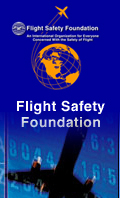
By Roger Rapoport
DAYTONA BEACH - Three of 2014's five commercial aviation crashes around the world were weather related. These tragic accidents took the lives of 326 passengers and crew on different aircraft flown by different air carriers in Taiwan, Mali and the Java Sea. Is something going wrong at aviation schools, flight academies and airline training programs?
For Professor Debbie Schaum, now in her 20th year teaching meteorology at Embry Riddle Aeronautical University here the answer is obvious:
"Most pilots, many dispatchers and air traffic controllers are not taking meteorology classes taught by meteorologists."
As she works with students from around the world, Schaum, who also was an Air Force meteorologist for 17 years, believes a majority of pilots around the world are not getting the training they need in weather science:
"If you take a weather class that is not taught by a meteorologist you do not get the depth of understanding you need to be a good pilot."
As planes take off and land at the adjacent Daytona Beach airport, Schaum sounds a bit like a missionary straining for her voice to be heard.
Is it possible that events like Air France 447 in 2009 and last year's Air Asia 8501 crash in the Java Sea could have been avoided entirely if the copilots in command had a deeper understanding of high altitude icing conditions which can shut down a plane's automation in seconds? Are there other problems such as an inability to correctly read onboard weather radar and mistakes being made by controllers?
Schaum notes that foreign pilots who come to American schools like Embry Riddle on scholarships "lack the depth of understanding needed because training requirements in their countries are not as stringent as ours. It's also clear that training for dispatchers and air traffic controllers is not as in depth as it must be. "
The tragic consequences were made clear by the still under investigation Air Asia 8501 crash off the coast of Borneo in December. The copilot on this Indonesia to Singapore flight was caught in a thunderstorm and asked for permission to climb above the storm from his assigned altitude of 32,000 feet.
"Clearly," says Schaum who has studied this event that took the lives of 162 passengers and crew, "this pilot with 2,391 hours, was flying well beyond his understanding of the weather."
How, despite radar coverage in the area, did he and his far more experienced captain manage to enter this crisis situation? Schaum theorizes that the pilot had accidentally strayed into the heart of the storm, an area painting red on the weather radar, "because either ice on the raydome housing the radar equipment or very heavy rainfall absorbed enough energy to attenuate the radar return. What appeared to be a gap where he could fly around the worst of the storm was actually a radar shadow that blocked the flight crew's view of a second storm cell looming right behind the first cell . The point is they shouldn't have been flying in this zone in the first place.
"Other planes in the area made it through the weather just fine. This Air Asia crew made the mistake of misreading their weather radar and jogging right into the very worst of the storm. The plane shouldn't have been there.
"If the pilot knew his meteorology he could have successfully navigated around this terrible weather area. Also he could have looked at readily available soundings and quickly realized that his proposed solution, climbing to an altitude of 38,000 feet was unthinkable.. When his request to climb was turned down by air traffic control there was another big mistake."
The controller's reason for turning down the route deviation, conflicting traffic, underscores his own misunderstanding of the emerging crisis. First and foremost any pilot in an emergency situation takes priority over other traffic. In this case there was no time to wait for the controller to act. It was the pilot's job to react to the crisis before him and the controller's job to reroute conflicting traffic as needed. Second, any controller should have realized that climbing at this point was out of the question due to the terrible storm and icing conditions above.
Professor Schaum explains why: "At the time of the crisis cloud top heights were up to 52,000 feet. By ascending the crew ran the risk of climbing into a region where, due to relatively low temperatures, there was potential icing as high as 40,000 feet. They couldn't fly over it."
The failure of either the pilots or the controllers to understand the icing risk may have been compounded by a second risk factor.
"At the time of the event," says Schaum, "surface winds from the west at 20 to 40 knots were colliding with winds from the upper level winds from the east at 20 to 30 knots. This wind shear would have sustained the updraft longer. That could potentially explain the flight's sudden jump up from 32,000 feet at the rate of 6,000 feet per minute. This could have potentially triggered an aerodynamic stall.
The big updraft combined with the potential of rime ice, supercooled water hitting the plane and freezing instantly, could also have contributed to a stall.
While the full story of the accident awaits a final report from crash investigators, it's clear that the pilots and controllers handling flight 8501 failed to fully understand the weather over the Java Sea on the morning of December 27, 2014.
"You can blame as many people as you want to," says Professor Schaum as a student enters her campus office to discuss a paper. "But it's obvious that meteorology training in many parts of the world is falling behind the needs of today's pilots and their airlines."
*****
Mr. Rapoport is the producer of the feature film Pilot Error which has its east coast premiere May 18 and 19 at Cinema Arts in Fairfax, Virginia.





 05-15 ж©ҹдёҠеә§дҪҚеўһеҠ её¶дҫҶеҒҘ...
05-15 ж©ҹдёҠеә§дҪҚеўһеҠ её¶дҫҶеҒҘ...







